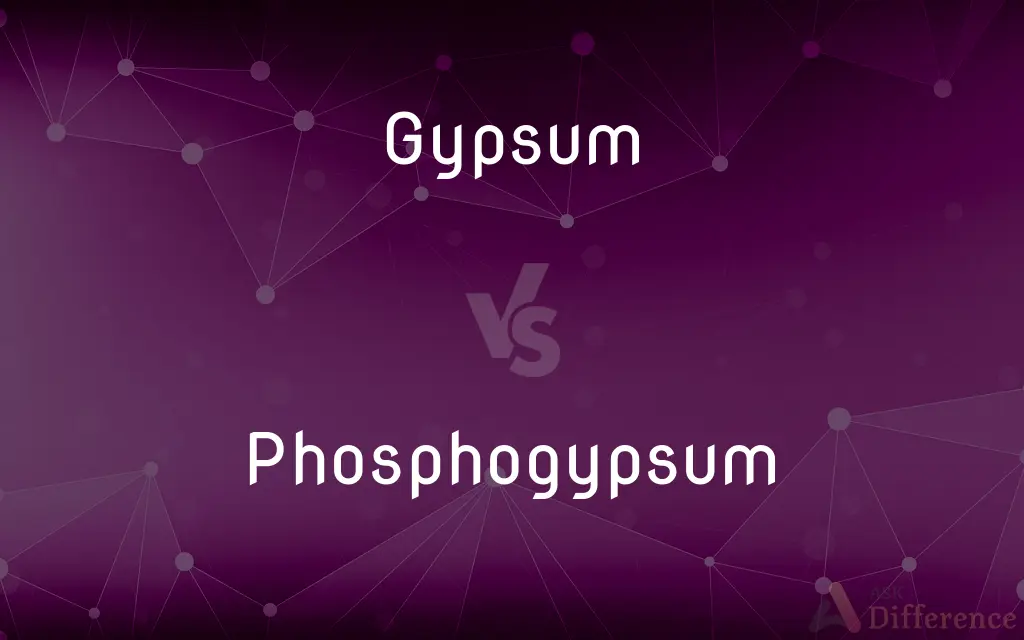Gypsum vs. Phosphogypsum — What's the Difference?
By Tayyaba Rehman & Urooj Arif — Published on August 21, 2024
Gypsum is a natural mineral used in construction and agriculture; phosphogypsum is a byproduct of processing phosphate rock for fertilizers, containing impurities.

Difference Between Gypsum and Phosphogypsum
Table of Contents
ADVERTISEMENT
Key Differences
Gypsum, a naturally occurring mineral, is widely used in the construction industry for products like drywall and plaster, owing to its ability to form a stable paste when mixed with water. On the other hand, phosphogypsum, a byproduct of producing phosphoric acid from phosphate rock, has limited applications due to the presence of impurities, including radioactive elements.
While gypsum has been used for centuries for building materials and as a soil amendment in agriculture, phosphogypsum has faced regulatory and environmental concerns that limit its use. Whereas gypsum's benign nature allows it to be safely incorporated into various products, phosphogypsum must be carefully managed to avoid environmental contamination.
Gypsum is valued in the agricultural sector for its sulfur and calcium content, which can improve soil structure and fertility. In contrast, phosphogypsum's potential as a soil amendment is often overshadowed by concerns about its heavy metal and radionuclide content, despite its similar nutrient content.
The production process of gypsum involves mining natural deposits, which can be found in many parts of the world. Phosphogypsum, however, is generated as a byproduct of the wet process for manufacturing phosphoric acid, where phosphate rock is treated with sulfuric acid.
Comparison Chart
Origin
Natural mineral deposit
Industrial byproduct
ADVERTISEMENT
Use
Construction, agriculture
Limited due to impurities
Environmental Concerns
Low
High, due to contaminants
Regulatory Status
Generally unregulated
Often subject to strict regulation
Nutrient Content
High in calcium and sulfur
Contains useful nutrients but with impurities
Compare with Definitions
Gypsum
Construction Material
Gypsum is used to make drywall for buildings.
Phosphogypsum
Limited Application
Use of phosphogypsum is restricted due to its impurities.
Gypsum
Soil Amendment
Farmers use gypsum to improve soil structure.
Phosphogypsum
Contains Impurities
Phosphogypsum can contain radioactive elements.
Gypsum
Widely Available
Gypsum deposits are found worldwide.
Phosphogypsum
Regulatory Challenges
Disposal of phosphogypsum is heavily regulated.
Gypsum
Natural Mineral
Gypsum is mined from natural deposits.
Phosphogypsum
Industrial Byproduct
Phosphogypsum results from processing phosphate rock.
Gypsum
Safe for Use
Gypsum products are considered environmentally friendly.
Phosphogypsum
Potential Soil Amendment
Despite concerns, phosphogypsum may benefit soils.
Gypsum
A widespread colorless, white, or yellowish mineral, CaSO4·2H2O, used in the manufacture of plaster of Paris, various plaster products, and fertilizers.
Phosphogypsum
(inorganic compound) A form of gypsum (calcium sulfate) formed as a by-product in the manufacture of phosphate fertilizers
Gypsum
A mineral consisting of hydrated calcium sulphate. When calcinated, it forms plaster of Paris.
Gypsum
A mineral consisting of the hydrous sulphate of lime (calcium). When calcined, it forms plaster of Paris. Selenite is a transparent, crystalline variety; alabaster, a fine, white, massive variety.
Gypsum
A common white or colorless mineral (hydrated calcium sulphate) used to make cements and plasters (especially plaster of Paris)
Common Curiosities
Why is gypsum considered environmentally friendly?
It is a natural mineral with low environmental impact.
What is gypsum used for?
Gypsum is primarily used in construction and agriculture.
What makes phosphogypsum different from gypsum?
Phosphogypsum is a byproduct with impurities, unlike natural gypsum.
Can phosphogypsum be used in agriculture?
Its use in agriculture is limited due to environmental concerns.
How is phosphogypsum produced?
It's produced from the manufacture of phosphoric acid.
What are the main concerns with phosphogypsum?
Concerns include radioactive content and heavy metals.
Is gypsum mining environmentally friendly?
Mining impacts are considered lower compared to other minerals.
Can gypsum improve soil health?
Yes, it can improve soil structure and nutrient content.
Why is phosphogypsum regulated?
Due to its potential environmental and health hazards.
Are there uses for phosphogypsum?
Limited, mainly research for potential applications.
Is gypsum a renewable resource?
Gypsum is considered non-renewable but is abundant.
How is gypsum processed?
It's mined and then heated to remove water.
What are the global reserves of gypsum like?
Gypsum is widely available with significant global reserves.
What is the difference in origin between gypsum and phosphogypsum?
Gypsum is natural, while phosphogypsum is an industrial byproduct.
Can phosphogypsum be made safe for use?
Treatment can reduce risks, but concerns remain.
Share Your Discovery

Previous Comparison
Norco vs. Vicodin
Next Comparison
Ethylene vs. EthylideneAuthor Spotlight
Written by
Tayyaba RehmanTayyaba Rehman is a distinguished writer, currently serving as a primary contributor to askdifference.com. As a researcher in semantics and etymology, Tayyaba's passion for the complexity of languages and their distinctions has found a perfect home on the platform. Tayyaba delves into the intricacies of language, distinguishing between commonly confused words and phrases, thereby providing clarity for readers worldwide.
Co-written by
Urooj ArifUrooj is a skilled content writer at Ask Difference, known for her exceptional ability to simplify complex topics into engaging and informative content. With a passion for research and a flair for clear, concise writing, she consistently delivers articles that resonate with our diverse audience.













































